Strategic Value Analysis for Competitive Advantage: An Illustration from the Petroleum Industry
Managers can do a far better job if they understand how each process they manage adds value. SVA is a tool for gaining that understanding.
This article will describe and illustrate a technique for assessing strategic positioning and for understanding strategic challenges, which has wide applicability across companies and across industries. We call it Strategic Value Analysis because it is based on the familiar value chain concept from the strategic management literature. What is different about Strategic Value Analysis is careful attention to quantitative relationships and analytically grounded insights. Such attention permits much richer and more explicit awareness of the underlying economic context shaping business choices.
Competitive advantage in the marketplace ultimately derives from providing better customer value for equivalent cost (that is, differentiation) or equivalent customer value for a lower cost (low cost). Occasionally, but not often, a company achieves both by providing better value at a lower cost -- I.B.M. in PC's in 1984 or Microsoft with Windows 95. What-ever the focus for a company, value chain analysis is essential to determine exactly where in the chain customer value can be enhanced or costs lowered. It is shortsighted to ignore linkages upstream from the company as well as downstream.
The value chain framework is a method for breaking down the chain -- from basic raw materials to end-use customers -- into strategically relevant activities in order to understand the behavior of costs and the sources of differentiation. We are aware of no companies that span the entire value chain in which they operate.
A company like Chevron spans wide segments of the petroleum value chain, from oil exploration to service stations, but it does not span the entire chain. Fifty percent of the crude oil it uses comes from other producers, and more than one-third of its refined product is sold through other retail outlets. Also, Chevron is not in the auto business, the major user of gasoline. More narrowly, a company like Apache is only in the oil exploration and production business. The Limited has downstream presence in retail outlets but owns no manufacturing facilities. Reebok is a famous shoe brand, but the company owns very few retail outlets. Reebok does, however, own its factories.
To recapitulate, a company is typically only a part of the larger set of activities in the value delivery system in which it participates. Since no two companies of which we are aware, even in the same industry, compete in exactly the same set of markets with exactly the same set of suppliers, the positioning within the overall value chain for each company is unique.
Suppliers not only produce and deliver inputs used in a company's value-adding activities, but they also importantly influence the company's cost/differentiation position. For example, developments by steel "mini-mills" lowered the operating costs of wire products users who are the customers of the customers of the mini-mill -- two stages down the value chain. Similarly, customers' actions can have a significant impact on the company's value-adding activities. For example, when printing press manufacturers created a new press of three meters width, the profitability of paper mills was affected. If paper machine width does not match some multiple of printing press width, scrap is generated, which is paid for by someone somewhere along the value chain. Mill profit was affected by customer actions even though the paper mill is two stages upstream from the printer who is a customer of the press manufacturer.
As we will discuss more fully, gaining and sustaining a competitive advantage requires that a company understand the entire value delivery system, not just the portion of the value chain in which it participates. Suppliers and customers and suppliers' suppliers and customers' customers have profit margins that are important to identify in understanding a company's cost/differentiation positioning, since the end-use customers ultimately pay for all the profit margins along the entire value chain.
In short, focusing only on a company's "value added" (revenues minus purchases) instead of its value chain involves two major shortcomings. It starts far too late and stops far too soon.
While Strategic Value Analysis can be a useful tool for explaining the relative position of companies in an industry, by far its greatest value is in helping to guide a plan for management action. In particular, SVA points to an overall structure, including markets and assets as well as the "lines and boxes" of reporting relationships, most likely to succeed in a specific part of an industry. These findings can be applied either in the context of a smaller niche player or for operating units of a multidivision corporation.
IS SVA APPROPRIATE FOR
MY COMPANY?
There are four tests that can be applied to determine whether SVA would be a helpful strategic tool for any company:
1. Are there new or emerging players in my industry (within any portion of the value chain) that may be more successful than existing players?
2. Are these companies positioned in the value chain differently from current players?
3. Are new market prices emerging across segments of the value chain? Are these markets sufficiently deep to reflect arm's-length trading?
4. If I used these market prices as transfer prices in my company, would it fundamentally change the way that my major operating units behave?
If the answer to these questions is "yes," SVA is likely to be an insight-provoking tool.
In the section below, we provide an illustration of SVA applied to the United States petroleum industry as it underwent dramatic change in the past three decades. We believe SVA is uniquely helpful in understanding that restructuring.
THE OIL INDUSTRY:
1960'S TO PRESENT DAY
In the 1960's, the oil industry in the United States was predominantly in the hands of a small group of companies, each operating with a business model based on the integration of the value chain from raw materials through to retail sales. These dominant companies drilled for crude with company-owned leases, shipped crude in company-owned tankers to company-owned refineries, moved refined products along proprietary pipelines to company-owned terminals, and then retailed these proprietary products through company-owned service stations.
Of course, vertical integration was never completely achieved, and notable exceptions to the integrated model existed, such as Amerada in exploration and production and the independent jobbers who played a role in gasoline retailing. Nonetheless, the dominant players in the industry were the integrated major oil companies. In 1975, the integrated companies controlled 89 percent of U.S. refining capacity. This organization reflected the historical growth of the industry, where securing a market outlet for crude was of primary concern. Without a significant downstream presence, a company was considered to be at a disadvantage in the monetization of its crude reserves. The notion of "balance" across the chain was a company-specific challenge, so a vertically integrated organization was entirely appropriate.
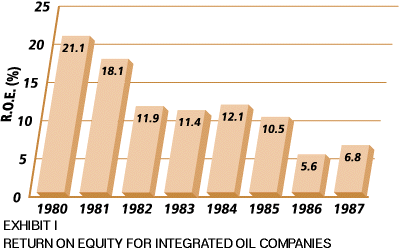
By the late 1980's and early 1990's, however, the U.S. oil industry looked dramatically different. The precipitating event in this transformation was the oil price crash of 1986, when average world oil prices fell by more than 50 percent. As a result, between 1985 and 1986, major integrated U.S. oil companies' upstream return on invested capital dropped from 12 percent to 3 percent. On its own, the U.S. downstream was not in great shape either. While vertical integration and cost-based transfer prices muddy the economic picture, there were clear warning signs. New refinery and terminal construction virtually ceased by the early 1970's, and the absolute number of retail outlets was in decline. Earning integrated returns well below the cost of capital (Exhibit I), the major oil companies were faced with a crisis. The "integration" paradigm broke down, with the upstream (exploration and production) decoupling from the downstream (marketing and refining). The remainder of this article focuses on the downstream, the restructuring of which was, as discussed in the example on the paper industry, largely caused by an event elsewhere in the value chain.
With the first big move toward decoupling, the downstream had to fend for itself. The majors first rationalized their asset base, selling off underperforming retail outlets, terminals and refineries to retain a more profitable "core." Further, they invested heavily in the core, recapitalizing their entire downstream asset base (Exhibit II).
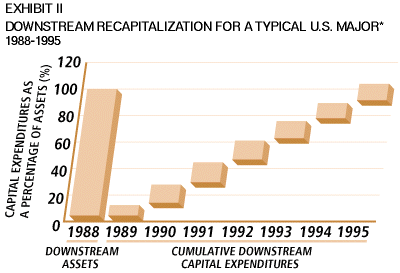
Yet, rather than seeing these new investments paid off by growing margins, downstream profitability declined in real terms from 1985 to 1995 (Exhibit III).
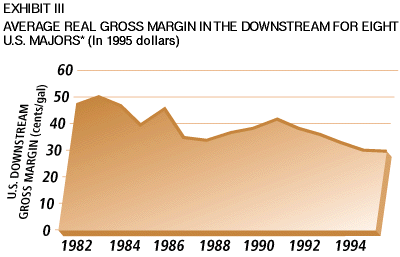
As a result, downstream returns for the U.S. majors have languished since the late 1980's (Exhibit IV). The majors' response seemed rational -- painful but necessary under the circumstances. What happened?
We believe SVA can help to understand why the asset rationalization/reinvestment failed to produce the desired effects, and how the rapid adaptation of a more focused, flexible operating model could have helped.
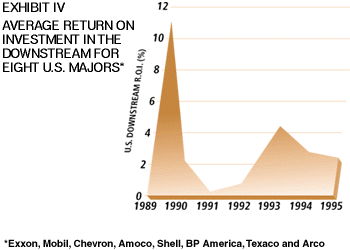
THE SVA TEST APPLIED TO
THE PETROLEUM INDUSTRY
Question 1: Are there new or emerging players in my industry (within any portion of the value chain) that may be more successful than existing players?
An SVA analysis of the U.S. petroleum industry during this period would have revealed the rise to prominence of a variety of new players, particularly in the downstream segment of the value chain. Often, these new players were purchasing assets that the majors had deemed uneconomic.
In the refining segment, Tosco aggressively acquired assets divested by majors, notably Exxon's Bayway refinery ($175 million) and Unocal's refining and marketing assets ($1.2 billion). GATX developed an independent business out of product terminaling by buying assets once viewed as a key link in the integrated value chain. Similarly, one of the major's distribution channels, the independent jobber, increased its role in the retailing segment as the majors sold off their marginal service stations. The balance clearly was shifting: in 1972, the majors sold less than 40 percent of their product through independent marketers; by 1995, the figure had grown to approximately 60 percent. New entrants, such as QuikTrip and Racetrac, were able to capitalize on the advent of self-serve gasoline. These companies aggressively developed gasoline retailing chains utilizing innovative retailing formats to optimize station economics.
The impact of new entrants is evident in the change in market share of the majors, for both upstream and downstream segments. For example, in 1974 the large integrated companies sold 43 percent of total U.S. volume through company-owned stations. By 1995, the majors held a market share of only 22 percent of total U.S. volume through company-owned stations. The major integrated companies' share of refining output decreased over this period as well (Exhibit V).
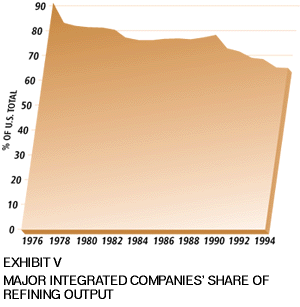
These new players generally were not considered by the majors as "competitors." Outside companies purchasing assets were often viewed as bottom feeders of secondary importance. Branded distributors were viewed as still part of the team since they carried the company brand upon sale (at least for a fixed period of time). The majors generally preferred to compare themselves only with other majors; they saw no reason to compare their integrated downstream structure with that of a distributor.
SVA Test No. 1 provides a clue here: New companies were entering a mature industry with poor returns. What were they up to?
Question 2: Do these companies utilize a different structure occupying a single value-chain segment or running multiple segments in a nonintegrated fashion?
These new companies were almost always structured in a dramatically different way from the industry's incumbents. They generally chose to focus on a narrow section, or even one segment of the value chain (Exhibit VI). For example, Tosco focused primarily on the refining segment. GATX focused largely on the product terminaling business, and Racetrac and QuikTrip were (and continue to be) retailing-only businesses.
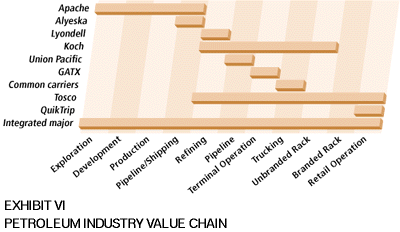
The benefits of a focused strategy are evident in the performance of QuikTrip, a 300-plus-store convenience and fuels retailer. By focusing solely on the marketing segment of the value chain, QuikTrip developed a superior retail offering distinguished by excellent customer service, competitive pricing and innovative merchandising techniques. As a result, QuikTrip's convenience sales per store were more than twice those of the average integrated major. QuikTrip viewed gasoline as simply another product, not as the cornerstone of the business or of site profitability. In addition, QuikTrip's nonintegrated flexibility allowed it to "colonize" new areas quickly, often constructing up to 50 locations in a given city in five years or less. QuikTrip bought its gasoline from many sources, so a major's question of "Do we have the refinery capacity to support a market expansion?" simply would not apply. QuikTrip is built on a retail concept, rather than an integrated supply chain.
Once again, SVA helps to understand not only the fact that new players are emerging, but also how their organizations differ from those of the major players. While there were literally hundreds of companies expanding in the downstream in the later 1980's to early 1990's, none had an organization similar to the major U.S. integrated companies.
Question 3: Are new market prices emerging across segments of the value chain that formerly have been integrated? Are these markets sufficiently deep to allow entry by new players?
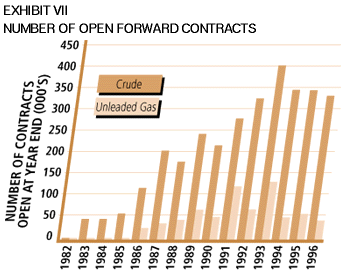
In the 1960's there were only a few low-volume spot markets available to nonintegrated companies. The first and most visible spot market was for crude oil. The spot market for crude grew from 54 cargoes in 1973 to nearly 6,000 cargoes in 1987. Trading in the spot market led to the New York Mercantile Exchange's creation of a crude oil futures market, which began trading in 1983. By 1984, more than 80 percent of the 50 largest companies were using futures contracts (Exhibit VII). Shortly thereafter, refined products, once strictly controlled by the majors for their proprietary retail networks, began to trade in New York Harbor and other major ports and in the futures market. While the development of a deep spot market for gasoline at major trading centers was important, by no means was it the only decoupling of the downstream value chain. Similar to the gasoline spot market, deep arm's-length markets developed at several other points in the downstream value chain, creating the transportation, terminaling and retail segments as identifiable, measurable niche businesses (Exhibit VIII). This market evolution occurred most quickly on the Gulf Coast and Eastern Seaboard. Yet, the majors still tended to view their downstream businesses on an integrated basis, with each asset class viewed as a "cost center" with a budget but little power over its own profitability.
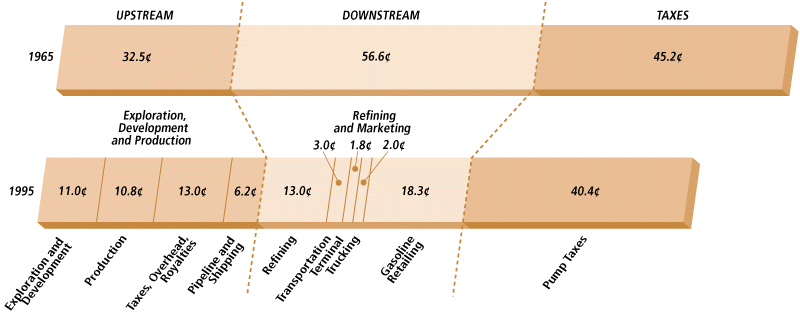
With Test No. 3, SVA explains how this different (decoupled) view of the business evolved to become an industry standard. The emergence of these multiple arm's-length markets indicated that the new players were viable in the marketplace.
Question 4: If I used these market prices as the basis for my company's transfer prices, would it fundamentally change the position that I want to occupy in the value chain? Would it change the way that my major operating units behave?
The possibilities suggested by these new operating models and new markets offered a dramatically different vision to the integrated oil companies. By using a market-based transfer price for intercompany sales, an integrated company could assess each segment of the value chain as an independent profit center. In addition, company performance now could be compared directly with new competitors despite their different operating practices. For example, a refinery no longer constrained to run its own company's crude might choose to purchase a different product slate that offered greater margins. A marketing organization run as a profit center would need to be competitive with both independent branded jobbers and unbranded retailers. The world would be different indeed.
In fact, the newly emergent players have acted in ways suggested by their value chain choices. Where captive refineries generally produce only up to the need of their marketing networks and adjust the product slate to satisfy those networks, Tosco operates its refineries strictly as "merchants," producing as much as possible of whichever product the market desires most. Whereas most integrated majors prefer not to lease space in company-owned terminals to unbranded retailers for fear of "tanking" the retail markets, GATX leases space to all paying customers and enjoys over 90 percent utilization.
It appears that the new players possess two common advantages, based at least partially on their approach to the value chain. Internally, they possess greater operating flexibility because they have no "commitment" to other company operations in different parts of the value chain. Their only commitment is to maximize their own segment profitability. Second, this flexibility allows them to focus externally on efficiently meeting market demand. The combination of these two factors allows these new players to thrive in spite of overcapacity and declining real margins.
SVA Test No. 4 is oriented toward the materiality of the observed changes on existing players. The majors viewed their asset classes (refineries, terminals, stations) as fundamentally linked. Instead, the emerging arm's-length markets suggested that this linkage was unnecessary and possibly dangerous. The early adoption of these arm's-length prices in the integrated U.S. majors would have allowed them to "face the market" more directly and better understand the attack of the new players.
AFTERMATH
The U.S. petroleum industry is now thoroughly decoupled, with significant players existing at each stage of the value chain. The integrated majors reacted to this restructuring at different rates, but most have now made strides to decouple their operations.
Majors and merchant refiners regularly trade product through exchange agreements. And, as noted previously, the majors have consistently reduced their direct ownership in the retailing business. However, downstream operations have only recently begun to decouple in an organizational sense -- as late as the early 1990's, many companies did not manage retail operations as stand-alone profit centers.
Indeed, only now are the majors recognizing that the new players have, in some cases, established superior capital efficiency and operating practices. This latent realization is driving a search for the next organizational model that will deliver consistent profitability. It is a search that could have started much earlier.
In a future issue of Strategy & Business, we will delve into the operating practices of a set of emerging downstream players to explain how they were able to expand profitability in a mature business at the expense of better established major companies.
CONCLUSION: THE SVA PERSPECTIVE FOR OTHER INDUSTRIES
The oil industry's SVA story presented here has parallels in many other industries. Consider, for example, the following industries in which SVA also represents a too-little-appreciated perspective:
Electric Utilities: The traditional model of integration across the three stages of power generation, transmission and distribution in regional monopolies is rapidly disintegrating. Decoupled regional, national and international markets by value chain segments are replacing monopoly restrictions. Where, across the value chain, is the profit earned today? Where will it be earned tomorrow?
Forest Products: Major uncertainties have led to widespread disagreement across the industry about the relative importance of fiber ownership, pulp manufacturing, paper manufacturing, conversion operations and downstream marketing in terms of sustainable profitability. Where in the value chain will profitability in the future support currently diverging investment patterns?
Food Products: This entire set of linked industries is undergoing fundamental restructuring, as illustrated in the widely publicized Efficient Customer Response (ECR) project. The relationships among manufacturing, factory distribution, wholesale distribution, retail supply logistics and retail merchandising are being rethought as the traditional value chain is totally revamped. The goal of the ECR project is to eliminate more than $35 billion a year in non-value-added costs along the food products value chain.
Financial Services: Major disagreements exist among the largest banks about value chain issues in such businesses as mortgage lending and credit cards. For a typical home mortgage, for example, is the overall aggregate profit that is earned between inception and payoff concentrated in origination, syndication (whole mortgages and "strips"), trading or servicing? NationsBank has divested origination and servicing operations while Fleet is expanding there. And, is credit card profitability over time more closely linked to growth in overall penetration (First USA) or to cost leadership in transaction processing (Citibank)?
Information Technology: Fifteen years ago the "small" computer business was dominated by companies like I.B.M. and Digital and NEC, which were highly integrated from microcircuits and hardware platforms through to operating systems, application software, distribution and field service. Today, the "small" computer business is a decoupled industry, with value chain linkages re-forming all the time in new ways. Virtually no one competes successfully all along the value chain anymore. There are now separate businesses in memory chips (Motorola), microprocessors (Intel), operating systems (Microsoft), hardware (Compaq), software (Oracle) and distribution (Dell). And, the boundaries among the segments are changing all the time.
We believe that variations of these stories can be told in virtually every industry today. A manager needs to be able to tell the SVA story for his or her company, for its current competitors and for future competitors, as the value chain in which the company competes reconfigures. In a subsequent issue we will pursue the SVA perspective further in the oil industry by analyzing the changing dynamics of retail in the United States in 1997.
DEFINING SVA
Strategic Value Analysis is a technique for quantifying business issues and opportunities across the entire value chain for an industry. It differs in two very important, and underappreciated, ways from typical business analysis:
1. SVA disaggregates activities into the fundamental building blocks of the full value chain, from suppliers all the way through to end-use customers, and then groups activities consistently with the way markets actually work. Most firms focus their analyses on only those activities where they are currently players.
2. SVA evaluates each stage of the chain on an economic value basis, cutting through the distortions often imposed by historical cost, transfer prices and accrual-based accounting.
What emerges with SVA is a clearer, more actionable view of competitive advantage, sources of profitability and areas for improvement at all stages of the value chain. This stage-specific understanding is critical in all multistage industries, because changes in one stage almost always impact businesses all along the chain. ![]()
Reprint No. 98103
| Authors
John K. Shank, John K. Shank is a professor at the Amos Tuck School of Business Administration at Dartmouth College. He is the author of 15 books, the most recent of which deals with strategic cost management, and more than 100 case studies and more than 100 journal articles. Dr. Shank received his M.B.A. from the University of Pittsburgh and his Ph.D. in accounting from Ohio State University. Eric A. Spiegel, spiegel_eric@bah.com Eric A. Spiegel is a senior vice president with Booz Allen Hamilton in Tokyo and the managing director of the firm’s international businesses outside the U.S. and Europe. His work focuses on strategy, organization, and operations improvement, primarily for large energy and industrial companies. Alfred Escher, Alfred Escher is a vice president in Booz-Allen & Hamilton's Houston office, where he focuses on the energy industry. Mr. Escher has consulted with most of the major private oil companies and several of the largest state-owned companies in the United States, Latin America, Asia-Pacific and Europe. Mr. Escher received a B.S.E. from Princeton University, an M.S. from the University of Southern California and a Master of Management from Northwestern University. |



